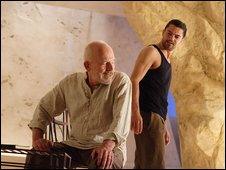Live screening 'good for theatre'
- Published

Helen Mirren played the title role in Nicholas Hytner's production of Phedre
A report on innovation in the arts has come up with the surprising finding that cinema audiences watching a live screening of a National Theatre play were more "emotionally engaged" than those watching it in the theatre.
The "intriguing" finding comes from research within two of the UK's leading cultural bodies - the National Theatre (NT) and the Tate.
The play was Jean Racine's Phedre, starring Dame Helen Mirren, which was broadcast to more 300 cinemas around the world on 25 June 2009.
The report - by the National Endowment for Science, Technology and the Arts (Nesta) - suggests the use of digital technology is crucial at a time when the arts world is facing a financial squeeze.
The research also found that live theatre screenings attracted a less affluent audience, and a "significant" minority who did not normally go to the theatre.
National Theatre director Sir Nicholas Hytner said that the NT was planning a bigger screening programme over the next year - including his own production of Hamlet.
The report said that audience for Phedre over its whole theatrical run was doubled through the screening of the single performance at the end of June.
"One of the most intriguing results from the National's NT Live screenings is that, despite lower expectations, cinema audiences reported higher levels of emotional engagement with the production than theatre audiences," the report said.
Commenting on the findings, Sir Nicholas told the BBC: "A huge number of the people who saw it on screen had never been to the NT because they lived very far away - so for them it was a very special experience.
"The close-ups, the clarity of sound, the sense that you can get behind an actor's eyes the way you can on a big screen in a movie really turned out to be an advantage."
As well as Oscar-winning actress Dame Helen, Phedre starred Dominic Cooper who appeared in the films Mamma Mia! and The Duchess.
Sir Nicholas said: "The important thing was to persuade everybody that what we were doing here was outside broadcast - not cinema.
"And to persuade the audience that what they were coming to was not the thing they might expect Helen Mirren to do after her Oscar-winning performance as The Queen - but what she would be doing in the theatre on that night."
Low income

Phedre co-starred John Shrapnel (Theramene) and Dominic Cooper (Hippolytus)
While most of the theatre audience had been to the NT in the previous 12 months, this was the case for only 41% of the audiences that saw Phedre in the cinema.
The research also found that the cinema screenings reached out to "low income audiences". One-third of cinema audiences had incomes of lower than £20,000 per year, compared with just over one-fifth in the case of the theatre audience.
"Clearly live screenings can help theatre overcome the traditionally-observed concentration of audiences amongst more affluent consumer groups," the report said.
Over one-third of cinema audiences said that, having seen the screening of Phedre, it was now more likely that they would attend a play at the National Theatre. Almost the same number again said they would do so at another theatre.
The report said it was too early to say whether live screenings could be a self-financing business model for the National Theatre, but "the signs are promising".
Digital exhibition
The report also studied the Tate Liverpool's Colour Chart exhibition in 2009 alongside its online offering.
The potential for art galleries, the report said, to generate money from online operations could not be compared with cinema screenings of theatre.
"No major art gallery in the world that we know of is currently charging online visitors for accessing digital exhibition content."
It found that the majority of online visitors "did not think it appropriate to pay to visit an exhibition website in the future".
However, half the online visitors said they would consider making an online donation to the Tate, but none did so when invited to via the Colour Chart webpages.
"Understanding the disconnect between what online visitors say they are willing to donate and what they do in fact donate should be a priority for arts organisations," the report concluded.
One of the Nesta report's authors, Hasan Bakhshi, said: "These are two examples of how in a tight funding environment one can do more with less and I think digital technology is one way of achieving that."
He added: "Digital technologies aren't just a threat, arts organisations can embrace them to promote their core missions - which is producing excellent art."